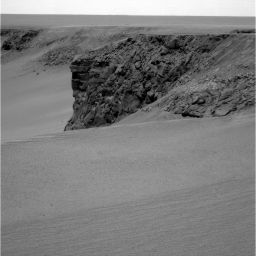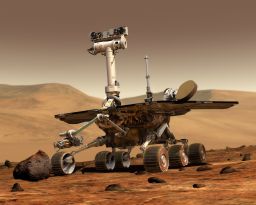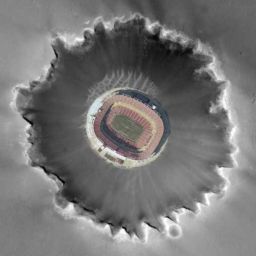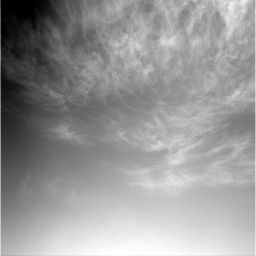A.J.S. Rayl • Oct 30, 2006
Mars Exploration Rovers Update: New Milestones Set as Spirit Celebrates 1000 Sols, Opportunity Digs Victoria with a Little Help from a Friend
The Mars Exploration Rovers managed to log another couple of significant milestones this month even as they worked in place, on autopilot, for the last two weeks during superior conjunction, the period that occurs every 2 years when Earth and Mars orbit into positions on opposite sides of the Sun, obscured from each other. With the conjunction now over, the rovers are slated to be back in command operation by tomorrow, All Hallow's Eve or, more popularly, Halloween.
The spotlight remained on Opportunity in October, perched now atop Cape Verde, one of the promontories overlooking the massive Victoria crater in Meridiani Planum. At the top of the month, the High Resolution Imaging Science Experiment (HiRISE) camera team on the Mars Reconnaissance Orbiter (MRO) mission released an image that showed the rover -- complete with the shadow of its mast and wheel tracks -- at Victoria crater, a picture that launched Mars and both missions back into the headline news. Spirit, meanwhile, soldiered on, quietly doing the work, getting to ready to make a long-awaited move, and achieving its own distinctions in the Columbia Hills area of Gusev Crater.
Spirit spent the month of October hunkered down in the same position it's been at Low Ridge since arriving nearly 6 months ago, pressing on dutifully with its winter campaign. Last Wednesday, October 25, 2006 -- just before Mars reemerged from behind the Sun -- the rover completed its 1000th sol on Mars. "I was astounded the rovers lasted one Earth year, not to mention Mars year, and now on beyond that," marveled Jake Matijevic, engineering team chief for MER at the Jet Propulsion Laboratory (JPL), where the rovers were built and are being managed. "It's extremely gratifying," he told The Planetary Society.
While it is a major milestone to be sure, it brought with it some real anxiety. "Sol 1000, for me, was more a worry than anything else, because all the sudden we've got 4-digit sol numbers, something our software was never set up to handle -- the S1K problem," Squyres explained, adapting the acronym from Y2K and the surrounding fear that when 1999 turned to 2000 computer systems around the world would crash, unable to handle the change. "We didn't know for sure if our software would break, so we actually devoted a lot of time and effort to dealing with the S1K problem and testing."
"A decision had been made [early on], because of what was an expected lifetime for these vehicles [90 days guaranteed] that we would represent the data that was received and plans created using 3 digits," Matijevic expounded. "Obviously, that's not going to work when we hit Sol 1K. Recognizing that we were going to survive that long meant coming up with a modification of all the scripts that we use routinely here on the ground to process the data and the plans in order to adapt them to a 4-digit sol number. That meant coming up with the mechanism by which we could do that, but also testing environment so that we could verify the tools could work and make sure that we caught all the problems that might arise because of this."
Although Sol 1000 has been "a significant nuisance" for the MER team on the ground, the rovers could have cared less. "We tend to operate these vehicles using a time that's counted up from January 1, 2000, so the vehicles it doesn't matter," explained Matijevic. "But for the planning tools, we actually verified that they worked with the Sol-1K changes simply by putting the plans together for Spirit in preparation for this time." The rover software, it appears, handled things just fine. And Spirit will be celebrating soon by moving for the first time in nearly 6 months.
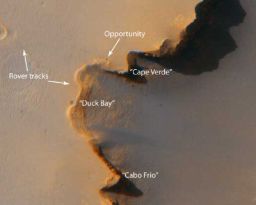 Opportunity from above
Opportunity from aboveThis image from the High Resolution Imaging Science Experiment (HiRISE) on the Mars Reconnaissance Orbiter shows the Mars Exploration Rover Opportunity near the rim of Victoria, an impact crater about 800 meters (half a mile) in diameter. Shown in the image are Duck Bay, the eroded segment of the crater rim where Opportunity first arrived at the crater; Cabo Frio, a sharp promontory to the south of Duck Bay; and Cape Verde, another promontory to the north. When viewed at the highest resolution, this image shows the rover itself, wheel tracks in the soil behind it, and the rover's shadow, including the shadow of the camera mast. After this image was taken, Opportunity moved to the very tip of Cape Verde to perform more imaging of the interior of the crater.Credit: Courtesy NASA / JPL / UA
On the other side of the planet, Opportunity has been "wowing" the MER team, planetary scientists, and the public with picture postcards since arriving at Victoria crater last month. More than just impressive pictures, these images delve into Martian history and have signaled, for all intents and purposes, that the mission has begun anew once again. Before Mars disappeared behind the Sun, this robot field geologist and its handlers were gifted with the HiRISE image, allowing the rover to safely rove to the edge of Cape Verde, one of the main promontories overlooking Victoria crater near Duck Bay.
That seemingly simple collegial gesture -- the hand-off of a picture from a team at the University of Arizona to the MER team at JPL and Cornell -- quietly launched Mars exploration into a new era.
"It is the first time we've had this coupled power of the orbiter in orbit that can see the rover on the ground and then the rover on the ground using the orbital images to plan where we're going to go," Squyres noted. "It's an extraordinarily powerful combination and we'll get to demonstrate this and be the first to get to use this kind of system, but I predict this is something that will be used extensively in the future."
Opportunity joined Spirit in staying put for the superior conjunction, which began on October 15, 2006. Interestingly, the exact dates of conjunction are determined by each mission at Mars. "With the rovers, we do it when the Sun-Earth-Mars angle is within 2 degrees, although some of the other missions use either 3 or 5 degrees. Whichever is used, it just constitutes a period when we understand the level of degradation [to the radio signals] that takes place because of the Sun particles on the command uplink, and so essentially we don't command at that period."
Superior conjunction, which comes round every 26 months, makes communication between teams on Earth and their spacecraft all but impossible for about 2 weeks because the line of sight between Earth and Mars -- or lack of it -- and position of the Sun can severely corrupt radio commands. For this reason, both rovers really had to go into "autopilot" mode; consequently, a special team was assigned the task of formulating the conjunction agenda for each rover. The commands -- which included scanning the Martian sky for clouds, measuring atmospheric dust, conducting chemical analysis of dust, rocks, and soils, and taking pictures -- ran for 15 days and, according to Squyres, each day's commands was unique in some way.
"This is very different than the last conjunction," Squyres said. "The last conjunction, we did very little science, and what we did do was extremely repetitive, essentially the same thing everyday. The ground software we had gave us the capability of planning only 1 day at a time, so we essentially planned 1 day and then relived it 15 times. Since we've gone to a mode of operations where on Fridays we plan multiple sols and now that we have the tools that can handle multiple sols, we were able to plan 15 sols, each of which is different from the others. So it should be a pretty rich science return from that 15-sol period."
Still, the rovers' schedules had to be kept light "simply because there was a desire not to try and fill up the onboard memory capacity," Matijevic pointed out. Way back at the beginning of the mission, Spirit's onboard memory overloaded and it brought the rover to an abrupt and frightening stop. So bad connections aside, some of the data collected during conjunction did trickle down to the MER team, in chunks no larger than 15-megabits, relayed as usual, via Mars Odyssey, though a good percentage of data was stored onboard for later transmission.
By comparison to the first conjunction 2 years ago, however, the rovers are "collecting lots of data," said Squyres. "We're simply not driving [Opportunity] because in order to drive you have to have the ground in the loop," he said. In other words, rover planners have to be able to see the after drive images to make sure the rover did as commanded and didn't encounter anything treacherous.
The rover workloads during conjunction made optimum use of solar power levels available to each rover. Although Spirit's solar power levels have increased to as much as 315 watt hours this month, it still averaged 2-hour work days, said Matijevic, with Opportunity averaging closer to 440 watt hours and a 3-hour workday. "Opportunity actually had more power than that recently -- we had been at around 480 watt hours of power on our approach to Victoria crater. But in order to get to this location, we had to tilt the vehicle adversely towards the Sun, so the power levels dropped a bit," he explained. "There will be a certain amount of variation from this point forward as we go to various locations around the crater."
Nearly 3 years after landing, Spirit and Opportunity have become a real rover dream team. As the Martian spring dawns, the twins remain in good "health." All the instruments -- except Spirit's rock abrasion tool (RAT) grinder that ground down long ago -- are still intact and functioning well, including the mini-TES on Opportunity, which continues to defy the odds day after day, and the panorama camera (PanCam) that has returned hundreds of stunning images and big images into which you can "immerse" yourself for hours.
With the rovers in autopilot mode, the humans working the mission went into vacation mode, making for a relatively quiet October overall in the land of MER. The team took "a wonderful, blissful, celestial mechanics-imposed vacation," said Squyres. "The 4th floor of the Space Sciences at Cornell [was] like a ghost town – it's been 26 months and the last superior conjunction since it's been like that. These rovers are such priceless assets that you can't just say, 'Gee everybody's tired. Let's take a 2-week vacation and come back." We can't do that. We have to keep pushing and keep on operating them. But to have a 2-week vacation forced upon us by the motion of the planets – that's fine."
Now the vacations are over. Mars emerged from conjunction for the rovers this past weekend and as All Hallow's Eve descends on big cities and tiny towns around the world, the MER team members are back at their stations sending new commands to the rovers.
Spirit from Gusev Crater
The focus for Spirit throughout October has primarily been atmospheric studies, although the rover balanced those research efforts with additional, close-up examinations of volcanic outcrop targets within reach of its instrument deployment device (IDD).
Spirit began the month as it has begun just about every morning this Martian winter, measuring atmospheric opacity, and surveying the sky and ground with the PanCam and the mini-thermal emission spectrometer (mini-TES). In addition, the rover used its Mössbauer spectrometer to analyze dust collected by the filter magnets and acquired PanCam images of its immediate work area, as well as collected images of its tracks with the mini-TES.
 McMurdo Panorama on the Occasion of Spirit's 1,000th Sol
McMurdo Panorama on the Occasion of Spirit's 1,000th SolSpirit captured this 360-degree view, called the McMurdo panorama, with its panoramic camera (PanCam) this winter at Low Ridge. It is the largest panorama taken top date on the MER mission. On October 26, 2006, marked Spirit's 1,000th sol of what was planned as a 90-sol mission. The panorama was released to celebrate this milestone and was produced from the most detailed imaging yet completed by either Spirit or its twin, Opportunity. The PanCam began shooting component images of this panorama during Spirit's sol 814 (April 18, 2006) and completed the part shown here on Sol 932 (August 17, 2006).
Credit: NASA / JPL / Cornell
During the first full week of the month, Spirit also collected compositional data for targets dubbed Casey Station, Sobral, and from Sol 979 to 981, took super high resolution images of volcanic outcrops called Marambio, Jubany, and Mitcheltree Ridge, and the soil target Tyrone. The outcrops, as it turns out, consist of basalt, the dense, dark rock that hardens from lava and often has a glassy appearance – in these cases, the basalt is porous and features many little holes formed from gas bubbles present in the lava when it solidified. The rovers rounded out the week by taking morning PanCam images of the horizon and of El Dorado, the 150-meter wide (500 foot) field of curving sand ripples at the base of Husband Hill, measuring the morning sky brightness in the west with the Pan Cam and scanning the sky for clouds with the NavCam.
As the month wore on, Spirit added more PanCam images to its portfolio, including more pictures of its own tracks, pictures of rock targets Gueslaga and Tor, as well as super high-resolution images of a target called Mitcheltree Ridge 11. The rover also used its mini-TES to examine Tor, and another rock target called O'Higgins. As monotonous as it may seem, the mountain of data that Spirit is collecting will allow scientists to see and more importantly better understand how the local environment interacts with the region.
Spirit spent much of its time during the superior conjunction on its atmospheric observations, monitoring the atmosphere and searching for any possible surface changes. But it also analyzed dust collected on the filter magnet with its Mössbauer spectrometer. "The reason Spirit focused more on atmospheric stuff during conjunction is two-fold: 1) we have less power; 2) we're still at Low Ridge -- there isn't anything here we haven't looked at," said Squyres.
While Opportunity is commanding the spotlight again and Spirit's fate of being stuck in one place for so long may seem to the outsider to be unbearingly boring, it really isn't for the MER team. "During this winter period, where the vehicle pretty much had to stand still, the planning was fairly simplified and not always interesting because of reduced energy levels, but this is a vehicle on Mars, and many of the team think of it in that sense," said Matijevic. "We hadn't had an opportunity to operate vehicles on Mars for many years, and so while this is less of a challenge and maybe less interesting in some respects than other times in the mission, the rover is still another asset on the planet."
"Spirit is doing fine," agreed Squyres. "Spirit's going to move again not long after conjunction," he confirmed. That move, actually, could happen this week. But the time it's spent at Low Ridge this winter has been well spent, Squyres said. Even though the rover had to stay rigidly in place, its solar arrays tilted just so to collect the maximum amount of sunlight possible in order to survive winter, it found some local targets right in front of it, at Halley, that are very rich in calcium sulfate. "That is not something we've seen a lot of," he pointed out. "We've seen a lot more magnesium sulfate than we've seen calcium sulfate, so that has been interesting." And no matter how boring Low Ridge may now seem to observers at this point, the science team members are still intrigued with those finely layered rocks just to the right of the rover. The plan to turn the rover to the right and go and look at those layered rocks up close is still on, Squyres said.
Once Spirit finishes its work around Low Ridge, it's going to really start moving. "Initial moves will probably be local along Low Ridge," said Squyres. "But I'm thinking that before Christmas we'll be heading out across the countryside. The thing we're really looking forward to then is getting back to Home Plate. We really have a sense of unfinished business there and Home Plate is less than 100 meters away, not far," he said. "The last time we were at Home Plate we were in a big hurry because winter was coming and power was getting worse and worse and we were in a bad location and we needed to move on. We had to zoom through Home Plate. But we found some interesting stuff there and none of us left there feeling, 'We've got this place all figured out.' So we're really looking forward to going back there. We want to be able to explore the other side of Home Plate in a more leisurely sort of fashion. After that, we'll move onto something new."
Despite the fact that Spirit has been all but immobile for some 6 months, no one is anticipating any real issues with it getting up and roving again -- this is no rusted tin man after all. "Our mechanical engineers haven't expressed any particular concerns," said Matijevic. "As a matter of comparison, we clearly did not move the actuators from the before launch until landing so that was a good 7 to 8 months' worth of the device being really fixed and we had no problem."
Of course, the rovers didn't have 2 years 10 month of exploring Mars under their belts then either. Even so, said Matijevic, "[t]hinking about them from that standpoint, as well as their recent history, there hasn't been particular issue with any one actuator [motor] not being used seeing a particular problem. The difficulty is that, other than that initial period, there isn't a comparable period where we haven't driven or moved."
Truth told, everyone's a little curious to see how the old rover will do. But the real challenge, Matijevic said, will come when Spirit hits the road. This rover is still, essentially a 5-wheeled rover, having lost use of its right front wheel more than a year ago.
"Since we had our first problems with the driving capability of Spirit with [the loss of] the right front steering actuator, it became more of a challenge, forcing our engineers to come up with strategies to successfully drive with the Spirit," said Matijevic. "Now in coming weeks here we'll return to some of those same kinds of issues as we're capable of being able to move away from this location and continue exploration in the basin area. It's really a different problem driving under those circumstances than as generally faced with any kind of terrestrial example of driving a robot vehicle. So it's really an engineering challenge to understand what the terrain interaction will be like with a 5-wheel vehicle and also how best to achieve some of the science objectives the scientists have always wanted us to accomplish with the vehicle of this kind, specifically precise positioning and getting the rover in a place and in position to do what they need to do."
Opportunity from Meridiani Planum
Since arriving at Victoria crater in September, Opportunity has managed to inject a kind of second wind into the mission. With a "big shot" of help from the HiRISE camera onboard the Mars Reconnaissance Orbiter (MRO), the highest-resolution camera ever to orbit Mars, put the Red Planet – and Opportunity in particular – back in the headline news as October fell on Earth.
Soon after arriving at Victoria Crater's Duck Bay last month, the rover was sent on its way to Cape Verde, one of the main promontories on that side of the crater. Six sols, 4 drives and 127.61 meters (419 feet) later, the rover arrived at the rock target Fogo near the tip of Cape Verde. Along the way, it made remote-sensing observations including a panorama from Duck Bay, imagery of Cape Verde, and the atmospheric science used its PanCam and mini-TES to observe the sky and ground, and measure atmospheric clarity.
After imaging Duck Bay for a mosaic image called Duck Bay 2 at the end of September, Opportunity pulled out its mini-TES to scan the target Cape Verde Maio. On Sol 955 (October 1, 2006), the rover assessed the clarity of the atmosphere, took images of Cape Verde Maio with its PanCam, then stowed and the rover drove 55.71 meters (183 feet) toward Cape Verde. As usual, after the drive, the rover took images with its hazard avoidance cameras, PanCam, and navigation camera, and unstowed its arm. Opportunity also used its navigation camera to look for clouds, and conducted more remote sensing before the Mars Odyssey communication window, and during the communications window, examined points in the sky and on the ground with its mini-TES.
On Sol 957 (October 3, 2006), a new day in Mars exploration began when Opportunity performed the coordinated observation with MRO. Within hours of receiving the downlink from the HiRISE camera the HiRISE team – of which Steve Squyres is a member -- presented the MER team with a picture – of their rover, a picture so good it showed the shadow of the rover's mast, and its tracks, as well as the distinctive outline of Opportunity itself.
"The image was acquired and it took a couple of days to get it down to Earth and get it processed and it was an excruciating wait, but the day that image became available was the day we were doing our final move out onto the tip of Cape Verde," recalled Squyres. "So the rover planners were planning a drive literally to the edge of the world from what we can see from the rover – there's a sharp lip and beyond that there's nothing we could see," he said, continuing with the story. "The lip we were worried about was on the far side of Cape Verde, a part we had not seen from our location in Duck Bay, so we had no idea what was over there."
It could have been a 40-degree slope or a vertical cliff or an overhang. "If it's a 40-degree slope, it's probably good solid ground and nothing to worry about," said Squyres. "If it's a vertical cliff, probably okay. If it's an overhang -- and there are overhangs on some of these promontories on Cape Verde -- you probably don't want to drive a rover out onto an overhang because the thing might collapse underneath you. We really wanted to know what was there."
The HiRISE team at the UA processed the image "as fast as they could" for the press briefing at NASA HDQ, Squyres continued. "The guys in Arizona managed to turn that image around in 2 hours and get the first look at it to us in time to get it to the rover planners. And they were able to use it tactically to satisfy themselves that the slope was not an overhang and that it was sufficiently gentle on the far side of that lip, that it was a safe drive. We actually used it for tactical planning the day it was available and it influenced our decision. It was a very useful image. And boy," he added, "was it nice to see that rover again."
Since Squyres is on the HiRISE team, he knew what to expect, but knowing and seeing in this case are 2 different things. "I sat down and calculated all this ahead of time. I knew we would be able to see the shadow of the mast . . . I knew the geometry the rover was parked in . . . where the Sun would be . . . how many pixels across the rover would be," he recounted. "And none of that prepared me for the moment I actually saw the image – the visceral emotional impact of seeing that lonely valiant looking little rover parked on the side of that cliff was just -- staggering. It hit me right in the gut when I saw it. Seeing that picture and seeing that rover again and being able to finally see Victoria crater with that kind of clarity – yeah, it was a rush."
In the days leading up to the superior conjunction, Opportunity, positioned at the tip of Cape Verde, 3.1 meters (10.2 feet) from the edge of the sharp drop off on the rim of Victoria crater to be exact, completed a long Mössbauer integration on a RAT hole it had just drilled in a rock target. At the same time, the rover began taking a big set of mini-TES observations on the interior of the crater and starting in on what will be the second of "what will hopefully be many PanCam panoramas of the crater," said Squyres.
During conjunction, Opportunity worked about 3 hours a day, completing its atmospheric research studies and using its spectrometers for long integrations of selected targets.
Currently, Opportunity is still at the tip of the promontory Cape Verde, awaiting its next instructions. "The big decision we have to make is which way to go -- clockwise or counterclockwise -- around this crater," Squyres said. That decision will come soon.
Support our core enterprises
Your support powers our mission to explore worlds, find life, and defend Earth. You make all the difference when you make a gift. Give today!
Donate

 Explore Worlds
Explore Worlds Find Life
Find Life Defend Earth
Defend Earth



